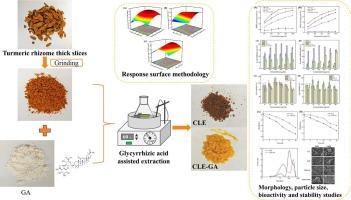甘草酸辅助绿色提取姜黄素的工艺优化:水溶性、生物活性和稳定性
IF 5.2
2区 化学
Q2 CHEMISTRY, PHYSICAL
引用次数: 0
摘要
姜黄素(Curcumin, CUR)是姜黄的主要活性物质。采用单因素试验结合响应面法对甘草酸辅助提取枸杞的工艺进行了优化。最佳提取率为20.00±0.03 mg/g,是同等条件下水提法的40倍,证实了该辅助提取方法的有效性。最佳提取条件为提取时间1.29 h,提取温度62.78℃,液料比(RL/S)为19.06 mL/g,甘草酸与姜黄粉的质量比(RG/T)为0.7。多重表征分析表明,GA与姜黄素通过氢键形成胶束包封结构,使提取物形貌呈无定形,粒径分布更为均匀,且其水溶性、抗氧化活性、抑菌活性和稳定性均优于CLE。CLE-GA体系表现出优异的性能,这可能是因为GA与CUR分子间结合能力较强,提高了CUR的水溶性,协同作用。综上所述,本研究证实了甘草酸辅助提取姜黄素是一种高效的提取方法,所得到的姜黄素提取物具有较高的生物活性、良好的水溶性和稳定性,为功能性食品和药物传递系统领域提供了绿色、可产业化的解决方案。本文章由计算机程序翻译,如有差异,请以英文原文为准。

Optimization of glycyrrhizic acid-assisted green extraction of curcumin from Curcuma longa: water solubility, bioactivity, and stability
Curcumin (CUR), as the main active substance of Curcuma longa. The process of glycyrrhizic acid-assisted extraction of CUR was optimized by a single-factor experiment combined with response surface methodology. The optimal extraction rate of 20.00 ± 0.03 mg/g, which was 40 times higher than water extraction under the same conditions, confirms the effectiveness of this assisted extraction method. The optimal extraction conditions were 1.29 h of extraction time, extraction temperature was 62.78 °C, liquid-to-solid ratio (RL/S) was 19.06 mL/g, The mass ratio of glycyrrhizic acid (GA) to turmeric powder (RG/T) was 0.7. Multiple characterization analyses showed that GA formed micellar encapsulation structure with curcumin through hydrogen bonding, which resulted in an amorphous morphology and a more homogeneous distribution of the particle size of the extracts, and the aqueous solubility, antioxidant activity, bacteriostatic activity and stability of CLE-GA (glycyrrhizic acid-assisted extract) were better than that of CLE (turmeric water extract). The CLE-GA system exhibits superior performance, which may stem from the stronger intermolecular binding ability between GA and CUR,improving the water solubility of CUR and synergizing the effect. In conclusion, this study confirms that glycyrrhizic acid-assisted extraction of curcumin is highly efficient, and the resulting extract combines high bioactivity, excellent aqueous solubility and stability, which provides a green and industrializable solution for the fields of functional foods and drug delivery systems.
求助全文
通过发布文献求助,成功后即可免费获取论文全文。
去求助
来源期刊

Journal of Molecular Liquids
化学-物理:原子、分子和化学物理
CiteScore
10.30
自引率
16.70%
发文量
2597
审稿时长
78 days
期刊介绍:
The journal includes papers in the following areas:
– Simple organic liquids and mixtures
– Ionic liquids
– Surfactant solutions (including micelles and vesicles) and liquid interfaces
– Colloidal solutions and nanoparticles
– Thermotropic and lyotropic liquid crystals
– Ferrofluids
– Water, aqueous solutions and other hydrogen-bonded liquids
– Lubricants, polymer solutions and melts
– Molten metals and salts
– Phase transitions and critical phenomena in liquids and confined fluids
– Self assembly in complex liquids.– Biomolecules in solution
The emphasis is on the molecular (or microscopic) understanding of particular liquids or liquid systems, especially concerning structure, dynamics and intermolecular forces. The experimental techniques used may include:
– Conventional spectroscopy (mid-IR and far-IR, Raman, NMR, etc.)
– Non-linear optics and time resolved spectroscopy (psec, fsec, asec, ISRS, etc.)
– Light scattering (Rayleigh, Brillouin, PCS, etc.)
– Dielectric relaxation
– X-ray and neutron scattering and diffraction.
Experimental studies, computer simulations (MD or MC) and analytical theory will be considered for publication; papers just reporting experimental results that do not contribute to the understanding of the fundamentals of molecular and ionic liquids will not be accepted. Only papers of a non-routine nature and advancing the field will be considered for publication.
 求助内容:
求助内容: 应助结果提醒方式:
应助结果提醒方式:


